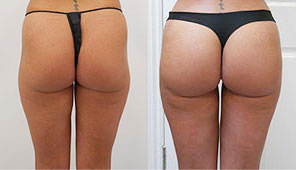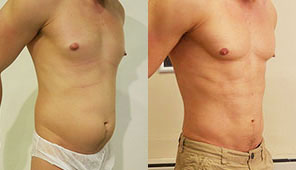
Jumpstarting a more youthful look is now easier than ever with the non-invasive skin-tightening treatment known as Ultherapy. The procedure is simple and time-effective; it has helped numerous patients achieve the fresher, facial appearance they are hoping for through an innovative skin lifting and tightening technique. If you’re interested in revitalizing your skin, schedule an appointment for a personal consultation with Dr Grant Hamlet. Call 0207 127 4377 to reach his offices in London, or fill out this simple online form, and one of our helpful staff members will reach out to you shortly.
About Ultherapy
Ultherapy utilizes micro-focused ultrasound energy in order to stimulate the production of collagen under the skin. When it comes to skin tightening and lifting, it is now considered to be one of the most effective treatments available today and is a simple, non-invasive procedure. The ultrasound energy is set to the right depth and temperature and works to contract existing collagen, while also stimulating the production of new, healthy collagen. Collagen is the amino-acid-rich protein that is responsible for maintaining the healthy function of the bones, skin, muscles, and tendons.[1] Ultherapy enriches the amount of existing collagen in the skin, making it tight and youthful, in areas where the skin may have either lost its elasticity or is beginning to loosen due to ageing.
A Closer Look at Skin
The skin is the largest organ that our bodies possess, and keeping it elastic and well-nourished can work wonders for one’s health, as well as one’s self-esteem. The skin is both complex and important and is made up of three layers: the epidermis, the dermis, and the subcutis. The skin’s layers have different functions and help to combat pathogens, protect against UV light, and heal injures.[1] Ultherapy uses ultrasound energy to create a thermal effect in the subcutaneous tissue, the areas that have the most abundant concentrations of collagen.
As we age, laxity in the skin occurs in the structural and foundational levels of the skin.[2] Ultherapy is designed to penetrate these deep layers of the dermis, without damaging the more superficial layers. The depth of stimulation during Ultherapy can run anywhere from 1.5mm to 4.5mm. Since the treatment does not affect the surface level of the skin—what is referred to in dermatology as the epidermis—this means that a patient is never left with any marks, bruising, or distortions following the treatment.
Areas That Can be Treated with Ultherapy
- Cheeks
- Forehead
- Browline
- Chin
- Jawline
- Neck
- Decolletage
Benefits of Ultherapy
One of the major benefits of Ultherapy is that the technique is a non-invasive treatment; because it is non-surgical, no incisions or chemicals are required, and no scars are left on the skin following the treatment. It is also time-effective. For example, Ultherapy can be used to lift the brow in just ten minutes with zero recovery time, making it a perfect anti-ageing treatment for anyone with a busy lifestyle. Furthermore, the treatment is customizable and can be combined with other treatments, such as injectables, for an extra boost to the skin or eyebrow area.
The thermal effect created by Ultherapy boosts elasticity and provides other anti-ageing benefits. Not only this, but the treatment is both FDA-approved and safe, making it one of the most important medical advancements in dermatology in recent years. The results are also long-lasting; a single treatment, for example, can offer benefits that can last for years. And perhaps most importantly, Ultherapy offers natural-looking results. Patients that opt for Ultherapy don’t have to worry about looking “done.” Results appear gradually, so patients are able to slowly transition into their new, youthful look, without anyone being able to tell that they’ve just had a rejuvenation procedure: they just have to wait to start enjoying the compliments!
To learn more about the other services that Dr, Hamlet offers patients at the Hamlet Clinic in London, follow his blog!
Candidates
Candidates for Ultherapy are usually in their 30s and older, and are frustrated with changes in their appearance caused by ageing. Candidates that notice sagging, or an aged look to their skin—such as the formation of jowls, drooping eyebrows, or lax skin under their chin, for example—may be good candidates for Ultherapy. It is also a suitable treatment for those wishing for firmer smoother skin on the neck, and to eliminate the “crepey” appearance that occurs in this delicate area. This procedure is non-surgical and can be used on all different skin types. However, patients with electrical implants should not receive Ultherapy, nor should women that are pregnant. If you’re looking for a fast, effective way to improve the appearance and vitality of your skin, don’t wait! Schedule a personal consultation with Dr Hamlet by calling 0207 127 4377 or reach out via an online form.
Personal Consultation
During your personal consultation, you’ll have the opportunity to discuss your problem areas as well as how this may be affecting your wellbeing and lifestyle. We’ll then determine whether Ultherapy will be a good solution. Following this discussion, patients will be given a personalized treatment plan that will be explained in detail. At the Hamlet Clinic, we’re dedicated to ensuring that each patient has the best experience and satisfying results.
Preparation
There’s not much you have to do to prepare for an Ultherapy session! You will need clean skin, so make sure the area that will be treated is free from makeup and other skin products. Apart from that, a patient is free to follow their regular dietary plan and exercise routine, as well as their work and family schedule before the treatment. Just be sure to avoid excessive sunlight!
Your Ultherapy Session in London
An Ultherapy session can take anywhere from as little as ten or twenty minutes to over an hour to perform. This involves an assessment through focused imaging, The skin is scanned by a microfocused ultrasound which shows a detailed image of the skin, muscle and fat. The focused image allows the technician to review the depth of muscle in the skin, and where the ultrasound energy needs to be applied in order for the patient to get the most satisfying results. Then, an ultrasound gel is applied to that area of the skin. No anaesthetic is required during the process. Then the Ultherapy hand piece is placed on the treatment area, where it emits ultrasound waves and creates heat beneath the skin, causing it to contract and lift. The thermal effect is around 60 to 70 degrees Celsius, optimal levels of heat to create this response in the skin.
In addition to the immediate tightening effect, Ultherapy also stimulates the body’s wound-healing response that helps to remodel the tissue on a long-term basis. [3]Ultherapy causes the skin, brow or other treatment area to produce additional stores of fresh collagen, which allows for lifting, tightening and an overall improved appearance.
Recovery
One of the major appeals of Ultherapy is that there is no recovery period. Following the treatment, patients are free to go about their daily work and life routines as normal. This is not the case with surgical treatments, for example, in which case a patient is often unable to return to work for a number of days or weeks. For this reason, Ultherapy is suited to people who are committed to tight schedules, and yet also wish to rejuvenate areas that are beginning to show signs of ageing.
Results
Immediately following the treatment, patients can expect the area of the skin that has undergone Ultherapy to appear slightly pink and tender. This is normal and means that the area has been activated and the collagen in the skin will gradually be replenished. Following this, within about six weeks patients will start to notice an improvement; the skin will begin to look fresher, tighter and more youthful. At the three-month mark, patients can expect to see the full benefits, with the skin appearing firmer and more robust. The treatment is often then repeated around the twelve or eighteen-month mark, in order to restore and upkeep a youthful, fresh appearance. This advanced, innovative technology can provide patients with satisfying results in areas of the skin that are damaged due to ageing, providing patients with a fresher, youthful appearance.
How Much Does Ultherapy Cost in London?
The total cost of your Ultherapy treatment will depend on the areas that you’d like to treat, and the number of sessions required to achieve your desired results. As such, the final price varies slightly from patient to patient. You’ll be given an accurate estimate following your personal consultation.
FAQ
Does Ultherapy hurt?
Ultherapy in non-invasive and non-surgical, but the thermal effect it creates is often compared to a tingling sensation or light electrical shock. The length of the procedure typically impacts how much discomfort the patient feels during a session, and some areas are more sensitive than others. However, most patients find that Ultherapy is tolerable.
What are the side effects from Ultherapy?
After an Ultherapy session, patients may notice light redness in the treated area, and experience a moderate amount of swelling that can last for a week or two after treatment.
References
- Lodish, H., Berk, A., S Lawrence Zipursky, Matsudaira, P., Baltimore, D., & Darnell, J. (2017). Collagen: The Fibrous Proteins of the Matrix. Nih.gov; W. H. Freeman. https://www.ncbi.nlm.nih.gov/books/NBK21582/
- Yousef, Hani; Alhajj, Mandy; Sharma, Sandeep. ‘Anatomy, Skin (Integument), Edpidermis in StatPearls, November 19, 2021. https://www.ncbi.nlm.nih.gov/books/NBK470464/
- Dierickx CC. The role of deep heating for noninvasive skin rejuvenation. Lasers in Surgery and Medicine. 2006;38(9):799-807. doi:10.1002/lsm.20446





